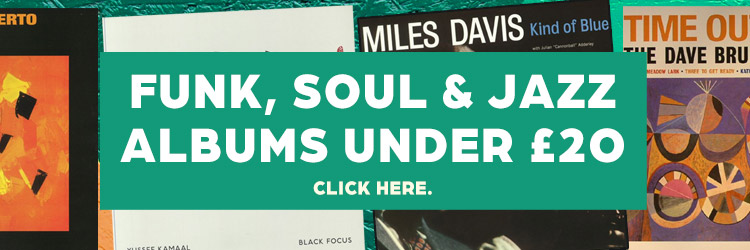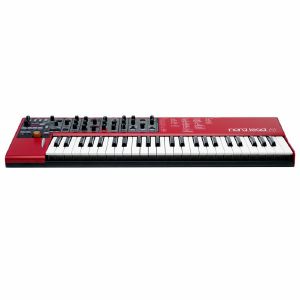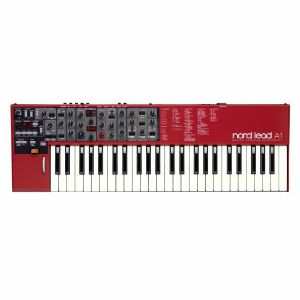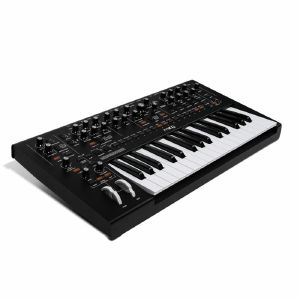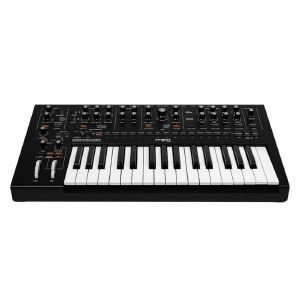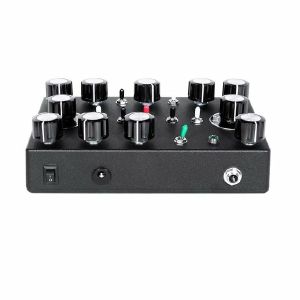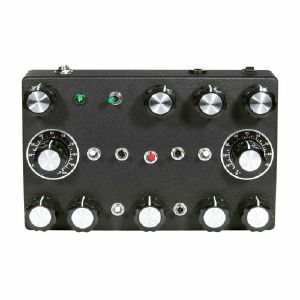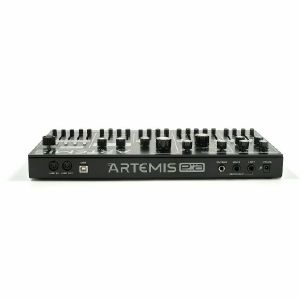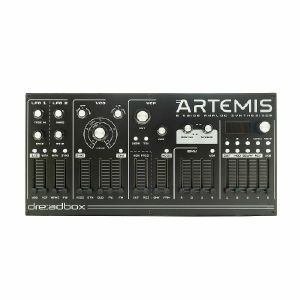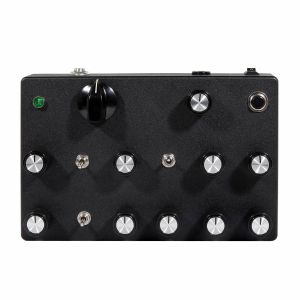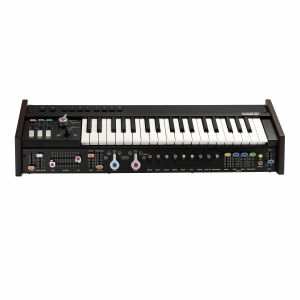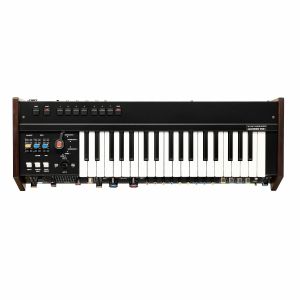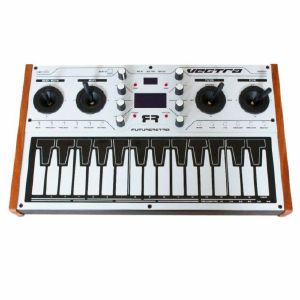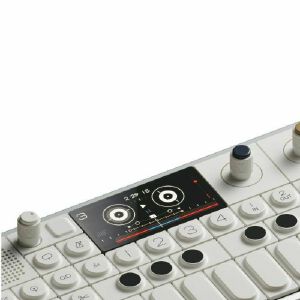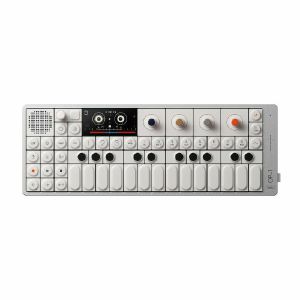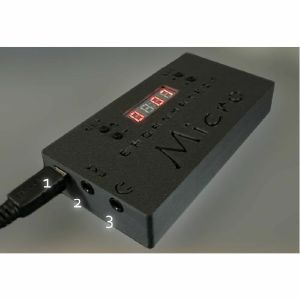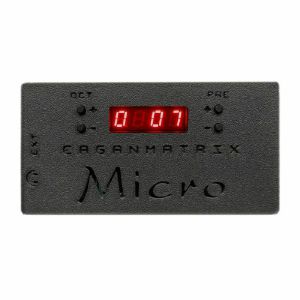Filter
Coming Soon
Equipment
Format
Featured
Price
Items 1 to 10 of 10 on page 1 of 1
Nord Lead A1 Analogue Modeling Synthesiser (hybrid keyboard synthesiser)
Cat: 1091534 Rel: 30 May 25
A 4-part multitimbral synth with a classic layout, extensive filter options and effects.
Notes: The Nord Lead A1 is a 4-part multitimbral synth with a classic layout, extensive filter options and effects. With its powerful panel interface and pre-programmed modulation matrix, creating unique and exciting sounds is very inspirational and quick.
At the heart of the Lead A1 is our new analog modeling engine. Taking our virtual analog synthesis to the next level, this modeling recreates a total analog signal path with uncanny realism, and is capable of immense sonic variety. With 26-voice polyphony and four simultaneous synthesizer parts, the Lead A1 is a true synthesizer powerhouse that goes far beyond the current trend for limited capability analog reissues.
Fundamental to the design of the Lead A1 is a brand new simple yet sophisticated front panel interface. The design is in fact the result of requests from professional players - even the most experienced programmers - who need to create the perfect sound as quickly as possible for today's live or studio time demands. The Lead A1 allows easy patch creation and experimentation thanks to a new and unique oscillator section, pre-programmed modulation matrix, and simplified ADR envelopes. Dive in and create incredible patches far quicker than would normally be possible with a synthesizer of such power.
The Lead A1's new Oscillator section generates 47 different waveforms from classic analog to digital harmonic and inharmonic waves, whilst unique Oscillator Configuration Shortcuts make programming more immediate than ever. Start with a single Oscillator waveform select an Oscillator Configuration Shortcut - Pitch, Detune, Shape, Sync, Sub Mix, FM, AM or Noise - and use the Adjust knob to adjust the settings of the configuration. The end result is high speed programming without the need for the usual complexity of routing and patching, and with the opportunity for ready experimentation. A fast track to stunning sound design for both advanced and less experienced programmers.
The Lead A1's filter section features classic 12 and 24 dB Low Pass, a High Pass and a Band Pass filter, together with stunning emulations of the diode and ladder filters from the legendary Mini and the TB-303 synthesizers as used in the Lead 4. The Lead A1's modeling of these filters capture the true character and response of the originals, allowing supremely flexible and precise sound design. The filters are super-smooth with a warm analog character.
The Lead A1's effects section features two stunning brand new analog models of an Ensemble and Chorus, modeled on specific vintage synths and adding classic warmth and analog feel. Alongside these, choose from great-sounding Ring Modulation, Phaser, Flanger, or Drive per slot, and in addition a separate Delay and Reverb for each slot.
A classic Nord feature, the Morph function via Mod Wheel, Velocity or pedal, allows you to control multiple parameters of the Lead A1 simultaneously. Morph is exceptionally easy to set-up and use - just hold the Morph button and adjust any desired knob.
The Lead A1 features four separate Arpeggiators with Up/Down and Random modes and a 4-octave range. Any or all can be sync'd to the Lead A1's master clock.
The Master Clock function of the Lead A1 allows the LFO, Arpeggiator and Delay to be synchronized, either internally or slaved to external MIDI clock. A Tap Tempo button allows you to easily tap to the tempo of a drummer or to playback tracks.
Having four identical, equally powerful synthesizers at once opens breathtaking layering possibilities. The Split-mode gives you two 2 slots on each side of the split. A flexible Hold functionality lets you latch and hold slots independently in the background while playing something else on top.
New in the Lead A1 is the Multi-Focus Mode that allows editing and control of all four slots simultaneously. Save this mode as part of a Performance and you have live realtime control over all four slots of the Lead A1.
The Lead A1 features four independent audio outputs with the ability to route each slot to a different output. Plus control of Pan via the front panel knob is a welcome new addition in the Lead A1.
Unique to the Nord Lead A1 is the new 'Like' function, a simple and brilliant practical feature to use during patch creation. When programming a patch it's often not clear if it's yet perfect. Now with the Lead A1 you can simply 'Like' what you've done into a temporary location and continue editing. You can Like up to 50 variations, with the ability to scroll between them to compare your favourites or go back to a specific Liked version to edit in a different way. When you're ready, save your favourite patch or patches to the Lead A1's memory.
A popular feature of the Lead 4, the Mutator function allows variations of a patch to be created by adjusting one, some, or all elements of a patch by set percentages. There's also a wild Randomize mode to create an entirely new patch with all parameters randomized.
A newly designed "Fat-As-Fat-Can-Be" Unison Mode let's the Lead A1 challenge any vintage analog instrument.
… Read moreAt the heart of the Lead A1 is our new analog modeling engine. Taking our virtual analog synthesis to the next level, this modeling recreates a total analog signal path with uncanny realism, and is capable of immense sonic variety. With 26-voice polyphony and four simultaneous synthesizer parts, the Lead A1 is a true synthesizer powerhouse that goes far beyond the current trend for limited capability analog reissues.
Fundamental to the design of the Lead A1 is a brand new simple yet sophisticated front panel interface. The design is in fact the result of requests from professional players - even the most experienced programmers - who need to create the perfect sound as quickly as possible for today's live or studio time demands. The Lead A1 allows easy patch creation and experimentation thanks to a new and unique oscillator section, pre-programmed modulation matrix, and simplified ADR envelopes. Dive in and create incredible patches far quicker than would normally be possible with a synthesizer of such power.
The Lead A1's new Oscillator section generates 47 different waveforms from classic analog to digital harmonic and inharmonic waves, whilst unique Oscillator Configuration Shortcuts make programming more immediate than ever. Start with a single Oscillator waveform select an Oscillator Configuration Shortcut - Pitch, Detune, Shape, Sync, Sub Mix, FM, AM or Noise - and use the Adjust knob to adjust the settings of the configuration. The end result is high speed programming without the need for the usual complexity of routing and patching, and with the opportunity for ready experimentation. A fast track to stunning sound design for both advanced and less experienced programmers.
The Lead A1's filter section features classic 12 and 24 dB Low Pass, a High Pass and a Band Pass filter, together with stunning emulations of the diode and ladder filters from the legendary Mini and the TB-303 synthesizers as used in the Lead 4. The Lead A1's modeling of these filters capture the true character and response of the originals, allowing supremely flexible and precise sound design. The filters are super-smooth with a warm analog character.
The Lead A1's effects section features two stunning brand new analog models of an Ensemble and Chorus, modeled on specific vintage synths and adding classic warmth and analog feel. Alongside these, choose from great-sounding Ring Modulation, Phaser, Flanger, or Drive per slot, and in addition a separate Delay and Reverb for each slot.
A classic Nord feature, the Morph function via Mod Wheel, Velocity or pedal, allows you to control multiple parameters of the Lead A1 simultaneously. Morph is exceptionally easy to set-up and use - just hold the Morph button and adjust any desired knob.
The Lead A1 features four separate Arpeggiators with Up/Down and Random modes and a 4-octave range. Any or all can be sync'd to the Lead A1's master clock.
The Master Clock function of the Lead A1 allows the LFO, Arpeggiator and Delay to be synchronized, either internally or slaved to external MIDI clock. A Tap Tempo button allows you to easily tap to the tempo of a drummer or to playback tracks.
Having four identical, equally powerful synthesizers at once opens breathtaking layering possibilities. The Split-mode gives you two 2 slots on each side of the split. A flexible Hold functionality lets you latch and hold slots independently in the background while playing something else on top.
New in the Lead A1 is the Multi-Focus Mode that allows editing and control of all four slots simultaneously. Save this mode as part of a Performance and you have live realtime control over all four slots of the Lead A1.
The Lead A1 features four independent audio outputs with the ability to route each slot to a different output. Plus control of Pan via the front panel knob is a welcome new addition in the Lead A1.
Unique to the Nord Lead A1 is the new 'Like' function, a simple and brilliant practical feature to use during patch creation. When programming a patch it's often not clear if it's yet perfect. Now with the Lead A1 you can simply 'Like' what you've done into a temporary location and continue editing. You can Like up to 50 variations, with the ability to scroll between them to compare your favourites or go back to a specific Liked version to edit in a different way. When you're ready, save your favourite patch or patches to the Lead A1's memory.
A popular feature of the Lead 4, the Mutator function allows variations of a patch to be created by adjusting one, some, or all elements of a patch by set percentages. There's also a wild Randomize mode to create an entirely new patch with all parameters randomized.
A newly designed "Fat-As-Fat-Can-Be" Unison Mode let's the Lead A1 challenge any vintage analog instrument.
1 in stock $1,452.15
Moog Messenger Monophonic Analogue Synthesiser (analogue keyboard synthesiser)
Cat: 1079390 Rel: 30 May 25
A new monophonic synthesiser featuring 32 fully weighted keys, dual looping ASDR envelopes, two oscillators and more.
Notes: A new method of sonic experimentation, communication, and connection has arrived. Say hello to Messenger, a next-generation analog synthesizer that celebrates classic Moog circuitry and introduces modern features to shape the future of sound design.
Messenger is a new Moog monophonic analog keyboard synthesiser designed for the electronic musicians, producers, sound designers, sonic tinkerers, and analog dreamers of today and tomorrow. Engineered to open new portals of art and expression through sound, the instrument is ready to be a trusted creative companion for any musical genre or style at any point in your synthesis journey.
If you're new to synthesis, welcome. You're exactly where you need to be. Messenger's intuitive layout with clearly labeled controls invites immediate hands-on exploration and encourages a deeper understanding of how to shape and sculpt sound. For experienced synthesists and sound designers, Messenger is packed full of innovative twists on beloved analog circuitry, blending the iconic, raw Moog sound with flexible, modern features designed for use on stage or in the studio. This synthesiser has two oscillators with wavefolding functionality, a sub-oscillator with continuously variable waveshapes, dual looping ADSR envelopes, 32 semi-weighted full-size keys with velocity and aftertouch, and the legendary Moog ladder filter augmented with resonance bass compensation, multiple filter slopes, and true multimode functionality. Messenger's 256 on-board presets allow for immediate saving and recall of your favorite sounds. An intuitive arpeggiator and expression/sustain pedal inputs make this an indispensable live tool, while its unique sequencer with probabilistic controls and modular connectivity set Messenger up to be at the core of your studio or home setup.
Craft soaring leads and deep, rumbling basses. Create delicately textured pads and flowing arpeggios. Build beats with custom kicks, snares, and toms. Explore dense drones and inharmonic metallics. Pay attention to how these sounds impact the way you hear the world around you.
Timeless and Intuitive: Messenger builds on the DNA of Moog's most iconic and prolific monosynths - Minimoog Model D, Voyager, Grandmother, Subsequent 37 - and puts a new spin on a familiar format with innovative circuits and timeless analog sound.
A Legend Reborn: The legendary Moog transistor ladder filter gets some new tricks up its sleeve. A unique pole-mixing design allows the ladder filter to preserve bass frequencies as resonance is increased via the RES BASS switch while keeping its sonic legacy intact. Low-pass mode adds a 2-pole filter slope in addition to the classic Moog 4-pole low-pass filter slope.
Inspiration at Your Fingertips: 32 full-size semi-weighted keys with velocity and aftertouch, a robust metal panel, 256 presets, and knob-per-function controls mean Messenger is endlessly playable and ready to bring to your next gig.
Compositional Powerhouse: Effortlessly record sequences of up to 64 steps, integrate chance operations, and introduce random fluctuations and parameter recording. Experiment with a plethora of arpeggiator patterns and cascade notes into infinity.
Sound Design and Modulation Playground: Two loopable ADSR envelopes, two LFOs, and expanded frequency and audio rate modulation options via Oscillator 2 provide a wealth of modulation options and deeper assignable possibilities.
Comprehensive Connectivity: Messenger integrates seamlessly into any studio or live setup with six analog control voltage (CV) patch points, an external audio input to the filter, expression and sustain pedal inputs, and 5-pin DIN MIDI in/out as well as MIDI over USB-C.
… Read moreMessenger is a new Moog monophonic analog keyboard synthesiser designed for the electronic musicians, producers, sound designers, sonic tinkerers, and analog dreamers of today and tomorrow. Engineered to open new portals of art and expression through sound, the instrument is ready to be a trusted creative companion for any musical genre or style at any point in your synthesis journey.
If you're new to synthesis, welcome. You're exactly where you need to be. Messenger's intuitive layout with clearly labeled controls invites immediate hands-on exploration and encourages a deeper understanding of how to shape and sculpt sound. For experienced synthesists and sound designers, Messenger is packed full of innovative twists on beloved analog circuitry, blending the iconic, raw Moog sound with flexible, modern features designed for use on stage or in the studio. This synthesiser has two oscillators with wavefolding functionality, a sub-oscillator with continuously variable waveshapes, dual looping ADSR envelopes, 32 semi-weighted full-size keys with velocity and aftertouch, and the legendary Moog ladder filter augmented with resonance bass compensation, multiple filter slopes, and true multimode functionality. Messenger's 256 on-board presets allow for immediate saving and recall of your favorite sounds. An intuitive arpeggiator and expression/sustain pedal inputs make this an indispensable live tool, while its unique sequencer with probabilistic controls and modular connectivity set Messenger up to be at the core of your studio or home setup.
Craft soaring leads and deep, rumbling basses. Create delicately textured pads and flowing arpeggios. Build beats with custom kicks, snares, and toms. Explore dense drones and inharmonic metallics. Pay attention to how these sounds impact the way you hear the world around you.
Timeless and Intuitive: Messenger builds on the DNA of Moog's most iconic and prolific monosynths - Minimoog Model D, Voyager, Grandmother, Subsequent 37 - and puts a new spin on a familiar format with innovative circuits and timeless analog sound.
A Legend Reborn: The legendary Moog transistor ladder filter gets some new tricks up its sleeve. A unique pole-mixing design allows the ladder filter to preserve bass frequencies as resonance is increased via the RES BASS switch while keeping its sonic legacy intact. Low-pass mode adds a 2-pole filter slope in addition to the classic Moog 4-pole low-pass filter slope.
Inspiration at Your Fingertips: 32 full-size semi-weighted keys with velocity and aftertouch, a robust metal panel, 256 presets, and knob-per-function controls mean Messenger is endlessly playable and ready to bring to your next gig.
Compositional Powerhouse: Effortlessly record sequences of up to 64 steps, integrate chance operations, and introduce random fluctuations and parameter recording. Experiment with a plethora of arpeggiator patterns and cascade notes into infinity.
Sound Design and Modulation Playground: Two loopable ADSR envelopes, two LFOs, and expanded frequency and audio rate modulation options via Oscillator 2 provide a wealth of modulation options and deeper assignable possibilities.
Comprehensive Connectivity: Messenger integrates seamlessly into any studio or live setup with six analog control voltage (CV) patch points, an external audio input to the filter, expression and sustain pedal inputs, and 5-pin DIN MIDI in/out as well as MIDI over USB-C.
More than 10 in stock $789.93
Click for better price!
or call +44 20 7424 1960
quote 1079390
quote 1079390
JMT Synth UNVO-1 Analogue Desktop Synthesiser (analogue desktop synthesiser)
Cat: 1060996 Rel: 21 May 25
Analogue desktop noise synthesiser
Notes: Excellent basic analogue synth with its own distinctive character. The UNVO-1 is a two-oscillator design with a 'strain' and filter circuit to sculpt your sound. Control via the knobby front panel for experimental tones and powerful bass sounds.
Supplier's Notes:
It is powered by a center negative DC 9V adapter or a single 9V battery.
It contains two VCOs (oscillators) with a wide range.
The SUB oscillator has a different frequency and waveform, and is input to the main, respectively. Each of them has a range switch, so it works like an LFO under the switch. The color of the range switch (white, black) corresponds to the color of the SUB.1 and SUB.2 on-off switches next to the FREQ knob of the main oscillator.
When the WAVE switch is turned on, the WAVE knob is activated, and the SUB OSCILLATOR.1 and 2 are shaken.
The main VCO×2 is mixed and fed into the strain + filter circuit. This special filter has a FREQ knob and a TUNE knob. The TUNE knob powerfully amplifies the input signal while also tracking specific pronunciations.
The filter is a circuit that has been fine-tuned so that it can very effectively enhance the bass and treble of this input signal.
Unlike other switches, the noise-on switch moves sideways, left (VCO.1), middle (OFF), and right (VCO.2). They are populated in VCO.1 and 2, respectively.
It is a noise machine that can output a very strong signal that generates a variety of noise sounds.
This analogue synth runs on DC9V negative center or a 9V battery.
The main 2 VCOs can receive 2 oscillators and noise generator inside and go to 2 different filters.
2 oscillators can be tuned with each two FREQ. knobs and controlled with the wave knob.
RED switch is for wave knob working.
Black and White for tone of oscillators
… Read moreSupplier's Notes:
It is powered by a center negative DC 9V adapter or a single 9V battery.
It contains two VCOs (oscillators) with a wide range.
The SUB oscillator has a different frequency and waveform, and is input to the main, respectively. Each of them has a range switch, so it works like an LFO under the switch. The color of the range switch (white, black) corresponds to the color of the SUB.1 and SUB.2 on-off switches next to the FREQ knob of the main oscillator.
When the WAVE switch is turned on, the WAVE knob is activated, and the SUB OSCILLATOR.1 and 2 are shaken.
The main VCO×2 is mixed and fed into the strain + filter circuit. This special filter has a FREQ knob and a TUNE knob. The TUNE knob powerfully amplifies the input signal while also tracking specific pronunciations.
The filter is a circuit that has been fine-tuned so that it can very effectively enhance the bass and treble of this input signal.
Unlike other switches, the noise-on switch moves sideways, left (VCO.1), middle (OFF), and right (VCO.2). They are populated in VCO.1 and 2, respectively.
It is a noise machine that can output a very strong signal that generates a variety of noise sounds.
This analogue synth runs on DC9V negative center or a 9V battery.
The main 2 VCOs can receive 2 oscillators and noise generator inside and go to 2 different filters.
2 oscillators can be tuned with each two FREQ. knobs and controlled with the wave knob.
RED switch is for wave knob working.
Black and White for tone of oscillators
1 in stock $297.20
Click for better price!
or call +44 20 7424 1960
quote 1060996
quote 1060996
Dreadbox Artemis 6-Voice Polyphonic Analogue Synthesiser (B-STOCK) (analogue desktop synthesiser)
Cat: 1091598 Rel: 01 Jan 90
B-STOCK: Box opened, product in perfect working order
Notes: ***B-STOCK: Box opened, product in perfect working order***
An evolution of the monophonic Typhon synth concept, the Artemis applies similar interface design to a six-voice analogue synth module with Sinevibes digital effects. Lots of power and typically classy Dreadbox sound.
Supplier's Notes:
Artemis is a unique analogue polysynth with a UI inspired by Dreadbox's award-winning Typhon synthesizer. It builds on Typhon's innovative concepts, adding six voices of polyphony, powerful modulation capabilities, stereo FX, voice spreading, and much more!
From classic polysynth tones to aggressive modern sounds and everything in between, Artemis has a wealth of raw synthesis and modulation capabilities to explore.
At its core, Artemis features a fully analogue architecture, based on the smart oscillator implementation found in both the Typhon and the Murmux Adept, allowing effortless transitions between multiple waveforms, mix settings, glide, FM, and more.
These VCOs are paired with Dreadbox's signature filter topology, offering classic 12dB or 24dB per octave low-pass modes, as well as a standalone resonant high-pass filter. The low-pass filter includes dedicated filter frequency FM control for dialling in edgier, modern tones.
Two multi-mode LFOs enhance the modulation possibilities: LFO 1 offers a unique fade-in parameter, while LFO 2 includes XMOD (cross-modulation) control for chaotic, brash textures. Each LFO has multiple waveforms and can modulate pitch, filter cutoff, VCO waveform, pulse width, and more.
This analogue powerhouse is complemented by a suite of world-class FX from Sinevibes, who previously collaborated with Dreadbox on Typhon's FX. With reverb, delay, modulation effects, master distortion, and more, Artemis delivers an extra dimension to your sounds.
… Read moreAn evolution of the monophonic Typhon synth concept, the Artemis applies similar interface design to a six-voice analogue synth module with Sinevibes digital effects. Lots of power and typically classy Dreadbox sound.
Supplier's Notes:
Artemis is a unique analogue polysynth with a UI inspired by Dreadbox's award-winning Typhon synthesizer. It builds on Typhon's innovative concepts, adding six voices of polyphony, powerful modulation capabilities, stereo FX, voice spreading, and much more!
From classic polysynth tones to aggressive modern sounds and everything in between, Artemis has a wealth of raw synthesis and modulation capabilities to explore.
At its core, Artemis features a fully analogue architecture, based on the smart oscillator implementation found in both the Typhon and the Murmux Adept, allowing effortless transitions between multiple waveforms, mix settings, glide, FM, and more.
These VCOs are paired with Dreadbox's signature filter topology, offering classic 12dB or 24dB per octave low-pass modes, as well as a standalone resonant high-pass filter. The low-pass filter includes dedicated filter frequency FM control for dialling in edgier, modern tones.
Two multi-mode LFOs enhance the modulation possibilities: LFO 1 offers a unique fade-in parameter, while LFO 2 includes XMOD (cross-modulation) control for chaotic, brash textures. Each LFO has multiple waveforms and can modulate pitch, filter cutoff, VCO waveform, pulse width, and more.
This analogue powerhouse is complemented by a suite of world-class FX from Sinevibes, who previously collaborated with Dreadbox on Typhon's FX. With reverb, delay, modulation effects, master distortion, and more, Artemis delivers an extra dimension to your sounds.
1 in stock $1,196.39
JMT Synth EGL-1 Analogue Desktop Synthesiser (analogue desktop synthesiser)
Cat: 1061069 Rel: 21 May 25
EGL-1 is a desktop analogue synthesiser that is ideal for a variety of duties; modulation capabailties, VCO routed through a boost circuit and much more
Notes: EGL-1 is a desktop analogue synthesiser that is ideal for a variety of duties. The unit's sub-oscillator can be configured to determine the emitted waveform and decays when the Push switch is pressed. There are four LFOs routed to the primary VCO for bountiful modulation capabilities. The VCO itself is routed through a boost circuit for a some extra flair that's sure to punish listeners in all the right ways.
EGL-1 Features
VCO routed through boost circuit
4 LFOs provide ample modulation possibilities
Integrated sub-oscillator
Push switch causes the sub-oscillator to decay
Two types of modulation can be applied to the MAIN VCO (oscillator).
The bottom stage mixes four LFOs and allows you to adjust the input level to the MAIN VCO with the level.
The middle stage allows you to input a WAVE to the SUB OSC (another oscillator) with adjustable rise and fall of the oscillator, which can then be fed into the MAIN VCO.
The push-button in the top right-hand corner rapidly decays the power of the SUB OSC as long as it is pressed. While it decays, it has an effect on the sound of the MAIN VCO.
The MAIN VCO output also has an output circuit to make the sound more powerful.
The EGL-1 operates from a 9V centre-minus or battery. Neither is included.
… Read moreEGL-1 Features
VCO routed through boost circuit
4 LFOs provide ample modulation possibilities
Integrated sub-oscillator
Push switch causes the sub-oscillator to decay
Two types of modulation can be applied to the MAIN VCO (oscillator).
The bottom stage mixes four LFOs and allows you to adjust the input level to the MAIN VCO with the level.
The middle stage allows you to input a WAVE to the SUB OSC (another oscillator) with adjustable rise and fall of the oscillator, which can then be fed into the MAIN VCO.
The push-button in the top right-hand corner rapidly decays the power of the SUB OSC as long as it is pressed. While it decays, it has an effect on the sound of the MAIN VCO.
The MAIN VCO output also has an output circuit to make the sound more powerful.
The EGL-1 operates from a 9V centre-minus or battery. Neither is included.
1 in stock $254.26
Click for better price!
or call +44 20 7424 1960
quote 1061069
quote 1061069
Korg miniKORG 700Sm 37-Key Analogue Synthesiser (analogue keyboard synthesiser)
Cat: 1066370 Rel: 22 May 25
A compact tribute to the iconic miniKORG 700, the very origin of Korg's analogue synth history, enhanced to meet the needs of today's musicians
Notes: A contemporary reboot of the 1970s miniKORG 700, the 700Sm introduces a second oscillator, MIDI, arpeggiator and spring reverb. All the features of 2021's limited-edition 700FS reboot in a more compact, portable package.
Supplier's Notes:
The miniKORG 700Sm is a compact tribute to the iconic miniKORG 700, the very origin of Korg's analogue synth history, enhanced to meet the needs of today's musicians. Featuring two oscillators for thick, detuned sounds, the miniKORG 700Sm sees the return of the signature Traveler controller, allowing for expressive filter adjustments. With advancements like aftertouch, spring reverb, an arpeggiator, and a range of connectivity options including USB and MIDI, this synth is both a powerful standalone instrument and an excellent companion to stage keyboards. Complete with a custom soft case and a free software bundle, the miniKORG 700Sm brings vintage analogue sound into the present day.
Released in 2021, the miniKORG 700FS was a spectacular recreation of the legendary 1970s miniKORG 700S analogue synthesizer, enhanced with additional functionality that wasn't possible in the original. The miniKORG 700FS was so popular that its limited production run sold out quickly, with significant demand for increased production. Korg has a long history of groundbreaking analogue synthesizers. The miniKORG 700Sm is a tribute to the miniKORG 700, the very origin of Korg's analogue synth history, while being enhanced to meet the needs of today's musicians.
Downsizing the miniKORG 700FS
The miniKORG 700Sm retains all the features of the miniKORG 700FS in an instrument approximately 86% the size of the original. Additionally, the miniKORG 700Sm weighs just 5.8 kg (12.8 lbs), making it easy to transport.
The elements vital to an analogue synth
The character and richness of the sounds produced by the miniKORG 700 could not be realized through analogue modelling. Although it's possible to replicate a circuit by using the same parts and copying the design schematics or circuit board, there's no guarantee that this will reproduce the original sound. This is because the components age over time, dramatically altering the sound. To accurately recreate the original sound, Korg had to rely on the experience and skill of the technicians who worked on the original product.
Korg were able to bring the original sound to life thanks to their team of technicians, who have gained invaluable expertise over the years through their work on numerous synthesizer revival projects. This team was guided by the legendary Fumio Mieda, a Korg engineer since the early 1970s and one of the designers of the original miniKORG 700S. Working closely with Korg's sound designers, they meticulously reproduced the original sound as faithfully as possible. Those who play the miniKORG 700Sm will experience it as a beautifully crafted and authentic recreation of the original.
Beautiful synth leads, thick bass - and more
The miniKORG 700 was Korg's first synthesizer, and produced some of the most recognizable, rich and fattest analogue sounds of the time. The new miniKORG 700Sm features oscillators with an unmistakeable tone and an authentic recreation of the Traveler controller- a signature element of the miniKORG 700- designed to add extraordinary colour and expression to performances. Its sound fits seamlessly in today's music, especially with its standout lead and bass synth tones.
Secondary keyboard possibilities
The miniKORG 700 was originally designed as a secondary keyboard, often placed on top of an organ to expand their sound palette. The miniKORG 700Sm, with its compact and portable form factor, stands out as a powerful solo instrument but also complements stage keyboards like electric pianos and organs perfectly.
The controls on the miniKORG 700 were laid out below its keys in a row, allowing players to easily access them when it was placed on top of another instrument. This intuitive layout remains unchanged, offering simplicity, ease of use, and a unique look that sets it apart from any other instrument.
Expanded functionality When the miniKORG 700 was originally released, electronic components were larger in size, limiting functionality due to the small space inside. Thanks to advancements in technology, there is now room to include a spring reverb as well as a joystick for pitch bend and modulation. The new version also features aftertouch for added expressiveness, as well as an arpeggiator, USB port, MIDI IN connector and a CV/GATE IN jack. Korg have also added memory programs to store settings, something that wasn't available in the early 1970s.
Traveler controller
A unique feature of the miniKORG 700, the Traveler controller, consisted of two parallel sliders located below the keyboard. With these controls, players could adjust the cutoff frequency, with the upper lever controlling the low-pass filter and the lower lever controlling the high-pass filter. This gave players the freedom to adjust the expressive character of the sound according to the position of the levers. By moving the levers to the left and right while playing the keys, wah-wah and muted sounds could be created along with the iconic "traveling" sound.
Since the sound passing through the filter has a lower cutoff frequency and higher cutoff frequency than the frequencies set by the sliders, all frequencies are filtered and thus no sound is heard when the positions of the two sliders are inverted. In other words, making the two sliders cross would in theory produce no sound. To address this, the original miniKORG 700 featured protrusions on the sliders to physically prevent them from crossing.
The design was both a benefit and limitation of analogue circuitry. In the past- and even today- it's impossible to design a filter with perfect characteristics. During the time that the miniKORG 700 was sold, some players would shave off the protrusions on the sliders to allow them to cross, in an attempt to create new sounds. In fact, some models sold internationally did not even have the protrusions to begin with. The miniKORG 700Sm also does not have the protrusions, opening endless sound design possibilities and allowing players to create patches in unique ways.
A second oscillator The miniKORG 700 was a single-oscillator mono synth. One year later 1974, the miniKORG 700S was released with more space added to the left of the keyboard for a controller. This version also introduced a second oscillator, a ring modulator, and other enhancements. The new Sm model is a revival of the 700S, with its expanded functionality, including two oscillators that deliver powerful detuning and thick, penetrating sounds, particularly for bass and lead sounds.
Includes a made-to-fit soft case
The miniKORG 700Sm comes with a custom-made soft case designed to perfectly fit the instrument, ensuring both protection and portability. This case makes it easy to take your miniKORG 700Sm wherever you go, whether you're performing, recording, or traveling, keeping your synth safe and secure.
Free music software bundle
The miniKORG 700Sm comes with a diverse variety of music software including Izotope (featuring "Ozone Elements" which lets you not only create songs but also master them using AI), "Skoove" which will help you improve your keyboard playing skills, "miniKORG 700S" from the Korg Collection software, as well as a wide range of software synths from Korg and other developers.
Specifications
Keyboard: 37 keys (Slim-key, with aftertouch, no velocity sensitivity)
Range: 7 octaves
Waveform: Triangle wave, Square wave, Sawtooth wave, Chorus I, Chorus II
Programs: 14
Input: USB connector (Type B), MIDI IN connector, SYNC IN and SYNC OUT jack (3.5mm monaural mini phone jack), CV IN and GATE IN jack (3.5mm monaural mini phone jack), AUDIO IN jack (6.3mm monaural phone jack, TS unbalanced)
Output: OUTPUT L/MONO and R jack (6.3mm stereo phone jack, TS unbalanced), Headphones jack (6.3mm stereo phone jack)
Power supply: AC adapter (DC 12V)
Power consumption: 9W
Dimensions (W × D × H): 641 x 228 x 107 mm/25.24" x 8.98" x 4.21"
Weight: 5.8 kg/12.79 lbs.
Included items: AC adapter, Traveler knob (without protrusions type) x 2, Soft case Accessories (sold separately)
SQ-CABLE-6 (Patch Cable)
… Read moreSupplier's Notes:
The miniKORG 700Sm is a compact tribute to the iconic miniKORG 700, the very origin of Korg's analogue synth history, enhanced to meet the needs of today's musicians. Featuring two oscillators for thick, detuned sounds, the miniKORG 700Sm sees the return of the signature Traveler controller, allowing for expressive filter adjustments. With advancements like aftertouch, spring reverb, an arpeggiator, and a range of connectivity options including USB and MIDI, this synth is both a powerful standalone instrument and an excellent companion to stage keyboards. Complete with a custom soft case and a free software bundle, the miniKORG 700Sm brings vintage analogue sound into the present day.
Released in 2021, the miniKORG 700FS was a spectacular recreation of the legendary 1970s miniKORG 700S analogue synthesizer, enhanced with additional functionality that wasn't possible in the original. The miniKORG 700FS was so popular that its limited production run sold out quickly, with significant demand for increased production. Korg has a long history of groundbreaking analogue synthesizers. The miniKORG 700Sm is a tribute to the miniKORG 700, the very origin of Korg's analogue synth history, while being enhanced to meet the needs of today's musicians.
Downsizing the miniKORG 700FS
The miniKORG 700Sm retains all the features of the miniKORG 700FS in an instrument approximately 86% the size of the original. Additionally, the miniKORG 700Sm weighs just 5.8 kg (12.8 lbs), making it easy to transport.
The elements vital to an analogue synth
The character and richness of the sounds produced by the miniKORG 700 could not be realized through analogue modelling. Although it's possible to replicate a circuit by using the same parts and copying the design schematics or circuit board, there's no guarantee that this will reproduce the original sound. This is because the components age over time, dramatically altering the sound. To accurately recreate the original sound, Korg had to rely on the experience and skill of the technicians who worked on the original product.
Korg were able to bring the original sound to life thanks to their team of technicians, who have gained invaluable expertise over the years through their work on numerous synthesizer revival projects. This team was guided by the legendary Fumio Mieda, a Korg engineer since the early 1970s and one of the designers of the original miniKORG 700S. Working closely with Korg's sound designers, they meticulously reproduced the original sound as faithfully as possible. Those who play the miniKORG 700Sm will experience it as a beautifully crafted and authentic recreation of the original.
Beautiful synth leads, thick bass - and more
The miniKORG 700 was Korg's first synthesizer, and produced some of the most recognizable, rich and fattest analogue sounds of the time. The new miniKORG 700Sm features oscillators with an unmistakeable tone and an authentic recreation of the Traveler controller- a signature element of the miniKORG 700- designed to add extraordinary colour and expression to performances. Its sound fits seamlessly in today's music, especially with its standout lead and bass synth tones.
Secondary keyboard possibilities
The miniKORG 700 was originally designed as a secondary keyboard, often placed on top of an organ to expand their sound palette. The miniKORG 700Sm, with its compact and portable form factor, stands out as a powerful solo instrument but also complements stage keyboards like electric pianos and organs perfectly.
The controls on the miniKORG 700 were laid out below its keys in a row, allowing players to easily access them when it was placed on top of another instrument. This intuitive layout remains unchanged, offering simplicity, ease of use, and a unique look that sets it apart from any other instrument.
Expanded functionality When the miniKORG 700 was originally released, electronic components were larger in size, limiting functionality due to the small space inside. Thanks to advancements in technology, there is now room to include a spring reverb as well as a joystick for pitch bend and modulation. The new version also features aftertouch for added expressiveness, as well as an arpeggiator, USB port, MIDI IN connector and a CV/GATE IN jack. Korg have also added memory programs to store settings, something that wasn't available in the early 1970s.
Traveler controller
A unique feature of the miniKORG 700, the Traveler controller, consisted of two parallel sliders located below the keyboard. With these controls, players could adjust the cutoff frequency, with the upper lever controlling the low-pass filter and the lower lever controlling the high-pass filter. This gave players the freedom to adjust the expressive character of the sound according to the position of the levers. By moving the levers to the left and right while playing the keys, wah-wah and muted sounds could be created along with the iconic "traveling" sound.
Since the sound passing through the filter has a lower cutoff frequency and higher cutoff frequency than the frequencies set by the sliders, all frequencies are filtered and thus no sound is heard when the positions of the two sliders are inverted. In other words, making the two sliders cross would in theory produce no sound. To address this, the original miniKORG 700 featured protrusions on the sliders to physically prevent them from crossing.
The design was both a benefit and limitation of analogue circuitry. In the past- and even today- it's impossible to design a filter with perfect characteristics. During the time that the miniKORG 700 was sold, some players would shave off the protrusions on the sliders to allow them to cross, in an attempt to create new sounds. In fact, some models sold internationally did not even have the protrusions to begin with. The miniKORG 700Sm also does not have the protrusions, opening endless sound design possibilities and allowing players to create patches in unique ways.
A second oscillator The miniKORG 700 was a single-oscillator mono synth. One year later 1974, the miniKORG 700S was released with more space added to the left of the keyboard for a controller. This version also introduced a second oscillator, a ring modulator, and other enhancements. The new Sm model is a revival of the 700S, with its expanded functionality, including two oscillators that deliver powerful detuning and thick, penetrating sounds, particularly for bass and lead sounds.
Includes a made-to-fit soft case
The miniKORG 700Sm comes with a custom-made soft case designed to perfectly fit the instrument, ensuring both protection and portability. This case makes it easy to take your miniKORG 700Sm wherever you go, whether you're performing, recording, or traveling, keeping your synth safe and secure.
Free music software bundle
The miniKORG 700Sm comes with a diverse variety of music software including Izotope (featuring "Ozone Elements" which lets you not only create songs but also master them using AI), "Skoove" which will help you improve your keyboard playing skills, "miniKORG 700S" from the Korg Collection software, as well as a wide range of software synths from Korg and other developers.
Specifications
Keyboard: 37 keys (Slim-key, with aftertouch, no velocity sensitivity)
Range: 7 octaves
Waveform: Triangle wave, Square wave, Sawtooth wave, Chorus I, Chorus II
Programs: 14
Input: USB connector (Type B), MIDI IN connector, SYNC IN and SYNC OUT jack (3.5mm monaural mini phone jack), CV IN and GATE IN jack (3.5mm monaural mini phone jack), AUDIO IN jack (6.3mm monaural phone jack, TS unbalanced)
Output: OUTPUT L/MONO and R jack (6.3mm stereo phone jack, TS unbalanced), Headphones jack (6.3mm stereo phone jack)
Power supply: AC adapter (DC 12V)
Power consumption: 9W
Dimensions (W × D × H): 641 x 228 x 107 mm/25.24" x 8.98" x 4.21"
Weight: 5.8 kg/12.79 lbs.
Included items: AC adapter, Traveler knob (without protrusions type) x 2, Soft case Accessories (sold separately)
SQ-CABLE-6 (Patch Cable)
2 in stock $1,309.76
Click for better price!
or call +44 20 7424 1960
quote 1066370
quote 1066370
Kiviak Instruments Wofi 10-Voice Polyphonic Sampler Synthesiser (B-STOCK) (digital keyboard synthesiser)
Cat: 1090913 Rel: 01 Jan 90
B-STOCK: Box opened, product in perfect working order
Notes: ***B-STOCK: Box opened, product in perfect working order***
Sampling meets the internet in the intriguing WoFi, a WiFi-enabled polyphonic instrument based around samples, granular synthesis and the online mywo.fi community platform.
Supplier's Notes:
WoFI is a portable Sampler keyboard that connects to the internet via WiFi, and features an innovative effect module called Texturer that combines elements of shimmer and granular synthesis to create unique and fascinating sounds. Its compact size and intuitive interface make it an ideal tool for musicians and producers who are always on the move. In addition, WoFI comes with a rechargeable battery, allowing you to create music anywhere you go without worrying about power. You can also share your patches and access sound banks from other sound designers through the mywo.fi community platform. Whether you're a beginner or a seasoned professional, WoFI offers endless possibilities for exploring new sonic territories and creating unique sounds.
Features
Player
The Player let you colour your sound with our emulations of classic samplers and their different sample player modes. Make it clean, dirty or anywhere in between.
Enveloppe
Sculpt your sound with the Enveloppe that can be assigned to WoFi's amp, filter or even both.
Manager
With the Manager and its display, get a visual feedback on all your tweakings, manage your sample library, access to mywo.fi content through WiFi and play with the touch strip. Oh, and there is no subscription needed for mywo.fi. Having WoFi gives you free access to community.
Filter
The Filter let you play the WoFi like classic subtractive synthesizers. It's a digital low-pass filter with two different slopes (12dB and 24dB) and a tasty resonance.
Texturer
The Texturer is here to bring you to unexplored sonic territories. Elevate your sound with this effect halfway between a shimmer FX and granular synthesis.
LFO
The LFO let you modulate your creation. With three different wave shapes, assign it to any parameter of the front panel and give motion to the sound.
Sequencer
The Sequencer let you build melodic patterns with the 16 polyphonic steps. It can be used as an arpeggiator. You can have your two hands free to play along the sequence and tweak your sound while it is looping. Oh, and you can also step sequence parameters, which makes it another modulation source in addition of the LFO and the Enveloppe.
Recorder
The Recorder let you either capture a sample from the line in or directly from the built-in microphone. It's easy as pie, pick your audio source with the switch, click on record and voila. Just like with the iconic first keyboard samplers.
Master
The Wofi is made to be played in many contexts, from your couch to the studio, so it has a full connectivity and two stereo audio outputs: one for your headphones and one for a master line-out and the WoFi internal speaker. Set your volumes easily.
Technical details
Player
- 48kHz 16 bits
- Direct streaming from flash, no preloading
- Polyphony 10 voices
Recorder
- 48kHz 16 bits mono
- Line / dynamic microphone / integrated microphone
- Gain adjust -6dB + 22dB
- Eurorack level compliant
Memory
- Flash embedded memory : 100 Mbytes, Flash cartridge memory : 100 Mbytes, Up to 200 User Patches + 50 Presets
100 MB allows storing 18 minutes of audio
Sequencer
- 16 steps track for notes
- 16 keys track for parameters sequencing
DSP
- Real time processing (No Preprocessing)
- Interpolation modes: sample & hold, linear, whittaker-shannon
- Pitch shift
- Time stretch
- Bit crusher
- Texturer
- Machine rendering emulation
- Resonant state variable filter (12dB/o-24dB/o)
- Parameter modulation from different sources : enveloppe, LFO, sequencer automations, external modulation (CV/MIDI), after touch, touch strip
- Texturer: self mixing renderer based on granular sampling - 8 grains - multi tap harmonizer
File servicing
- Direct file system management through USB
- Embedded sample editor
Network
- WIFI connectivity, up to 16 key pass
- Cloud access: Patch / Sample upload and download, sharing or backup.
Connectivity
- Sync clock + start/stop
- CV input, Gate input
- CV output, modulation output, gate output
- MIDI in, out, through DIN+USB
- Line In, Line out, Headphones
Miscellaneous
- USB powered
- Embedded battery - roughly 4h autonomy
- Integrated Microphone
- Integrated Speaker
- Full backup to Cartridge or mywo.fi
- User friendly workflow
- Aluminium / wood body
- Dimensions: 52cm x 23cm x 7cm
… Read moreSampling meets the internet in the intriguing WoFi, a WiFi-enabled polyphonic instrument based around samples, granular synthesis and the online mywo.fi community platform.
Supplier's Notes:
WoFI is a portable Sampler keyboard that connects to the internet via WiFi, and features an innovative effect module called Texturer that combines elements of shimmer and granular synthesis to create unique and fascinating sounds. Its compact size and intuitive interface make it an ideal tool for musicians and producers who are always on the move. In addition, WoFI comes with a rechargeable battery, allowing you to create music anywhere you go without worrying about power. You can also share your patches and access sound banks from other sound designers through the mywo.fi community platform. Whether you're a beginner or a seasoned professional, WoFI offers endless possibilities for exploring new sonic territories and creating unique sounds.
Features
Player
The Player let you colour your sound with our emulations of classic samplers and their different sample player modes. Make it clean, dirty or anywhere in between.
Enveloppe
Sculpt your sound with the Enveloppe that can be assigned to WoFi's amp, filter or even both.
Manager
With the Manager and its display, get a visual feedback on all your tweakings, manage your sample library, access to mywo.fi content through WiFi and play with the touch strip. Oh, and there is no subscription needed for mywo.fi. Having WoFi gives you free access to community.
Filter
The Filter let you play the WoFi like classic subtractive synthesizers. It's a digital low-pass filter with two different slopes (12dB and 24dB) and a tasty resonance.
Texturer
The Texturer is here to bring you to unexplored sonic territories. Elevate your sound with this effect halfway between a shimmer FX and granular synthesis.
LFO
The LFO let you modulate your creation. With three different wave shapes, assign it to any parameter of the front panel and give motion to the sound.
Sequencer
The Sequencer let you build melodic patterns with the 16 polyphonic steps. It can be used as an arpeggiator. You can have your two hands free to play along the sequence and tweak your sound while it is looping. Oh, and you can also step sequence parameters, which makes it another modulation source in addition of the LFO and the Enveloppe.
Recorder
The Recorder let you either capture a sample from the line in or directly from the built-in microphone. It's easy as pie, pick your audio source with the switch, click on record and voila. Just like with the iconic first keyboard samplers.
Master
The Wofi is made to be played in many contexts, from your couch to the studio, so it has a full connectivity and two stereo audio outputs: one for your headphones and one for a master line-out and the WoFi internal speaker. Set your volumes easily.
Technical details
Player
- 48kHz 16 bits
- Direct streaming from flash, no preloading
- Polyphony 10 voices
Recorder
- 48kHz 16 bits mono
- Line / dynamic microphone / integrated microphone
- Gain adjust -6dB + 22dB
- Eurorack level compliant
Memory
- Flash embedded memory : 100 Mbytes, Flash cartridge memory : 100 Mbytes, Up to 200 User Patches + 50 Presets
100 MB allows storing 18 minutes of audio
Sequencer
- 16 steps track for notes
- 16 keys track for parameters sequencing
DSP
- Real time processing (No Preprocessing)
- Interpolation modes: sample & hold, linear, whittaker-shannon
- Pitch shift
- Time stretch
- Bit crusher
- Texturer
- Machine rendering emulation
- Resonant state variable filter (12dB/o-24dB/o)
- Parameter modulation from different sources : enveloppe, LFO, sequencer automations, external modulation (CV/MIDI), after touch, touch strip
- Texturer: self mixing renderer based on granular sampling - 8 grains - multi tap harmonizer
File servicing
- Direct file system management through USB
- Embedded sample editor
Network
- WIFI connectivity, up to 16 key pass
- Cloud access: Patch / Sample upload and download, sharing or backup.
Connectivity
- Sync clock + start/stop
- CV input, Gate input
- CV output, modulation output, gate output
- MIDI in, out, through DIN+USB
- Line In, Line out, Headphones
Miscellaneous
- USB powered
- Embedded battery - roughly 4h autonomy
- Integrated Microphone
- Integrated Speaker
- Full backup to Cartridge or mywo.fi
- User friendly workflow
- Aluminium / wood body
- Dimensions: 52cm x 23cm x 7cm
1 in stock $660.53
Future Retro Vectra 29-Keys Hybrid Synthesiser (B-STOCK) (hybrid keyboard synthesiser)
Cat: 1090104 Rel: 01 Jan 90
B-STOCK: Box opened, product in perfect working order
Notes: ***B-STOCK: Box opened, product in perfect working order***
Future Retro's unique modern take on vector synthesis takes full advantage of an impressive hybrid synth engine. Digital oscillators, ring modulation and complex envelopes meet a multi-mode analogue filter with paraphonic capabilities. Quirky and flexible.
Supplier's Notes:
The Vectra is a unique hybrid synthesizer with a flexible architecture that allows many different forms of synthesis to be realized. It's the best of both worlds... The Vectra utilizes digital oscillators, ring modulators, noise sources, vector mixer, LFO's, complex envelopes, and modulation routings providing many capabilities that would be very difficult to produce with analogue circuitry alone. This allows for accurate tuning, repeatability of complex patches, and patch storage. The Vectra also provides a multi-mode analogue filter, VCA, and final output, as these provide the best sonic qualities.
The Vectra includes a powerful and fun sequencer and arpeggiator, with many new capabilities. Although the Vectra is a self contained instrument, MIDI can be used to interface with other devices.
The Vectra provides four oscillators, white and pink noise sources, four ring modulators, a four-channel mixer, five LFO's, six morphing envelopes, six primary multimode analogue filter types, a main analogue VCA, and numerous internal modulation routings and VCA's controlling modulation amounts.
It really is like having a powerful self-contained semi-modular synthesizer with approximately 500 internal signal routings, and around 256 storable sound parameters.
The synthesizer architecture is designed to allow the greatest flexibility in recreating multiple synthesis techniques of the past while introducing several new innovations. The sound section has been inspired by features of the greatest synthesizers ever made, while not focusing specifically on recreating any instrument in particular. The Vectra is in fact it's own unique self-contained instrument.
The oscillators are digital as this provides the highest degree of tuning stability, while allowing both virtual analogue and digital waveform generations. With features like oscillator Sync, PWM, the new waveform Phase Slice, and Fade features, independent glide times per oscillator, constant beat detuning, and paraphonic voice modes, not to mention FM, AM, ring-modulation, and dedicated LFO's, envelopes, and VCA's per oscillator really make these oscillators a power house.
The four-channel mixer is unique in that it provides an even balance when mixing multiple sources, either manually with the joystick, or applying automated vector mixing, or mixer modulation.
OSCILLATORS (1-4)
Frequency Range: <0.01 Hz to 20.00 kHz
Analogue Modelled Waveforms: Sine, Triangle, Sawtooth, Square, Pulse Width Modulated
Pulse Width Range: 1% to 99%
Pulse Width Modulation Sources: Random1/2, Key1/2, Velocity, Aftertouch, Mod-Wheel, Stick X/Y,
LFO, Envelope
Digital Waveforms: 500
Number of Digital Waveforms per Oscillator: 2
Waveform Modulation Types: PWM, Slice, Fade
Waveform Start: 0 to 255 samples
Waveform Modulation Sources: Random1/2, Key1/2, Velocity, Aftertouch, Mod-Wheel, Stick X/Y,
LFO, Envelope
Waveform Modulation Amount: 0 to 100
Octave Range: -7 to +5
Pitch Tuning: Semitones
Fine Tuning: 128 steps per semitone
Constant Beat Detuning: -/+5.00Hz
Paraphonic Modes: 8 total
Sync: Off/On, 0-360 degrees
Glide Time per Oscillator: 0ms to 14.7 seconds
Key Tracking: On/Off
OSCILLATOR FREQUENCY MODULATION (1-4)
Modulation 1 Source: LFO
Modulation 1 Control: Off, Random1/2, Key1/2, Velocity, Aftertouch, Mod-Wheel, Stick X/Y, LFO,
Envelope
Modulation 2 Source: Envelope
Modulation 2 Control: Off, Randon1/2, Key1/2, Velocity, Aftertouch, Mod-Wheel, Stick X/Y, LFO,
Envelope
Modulation 3: Randon1/2, Key1/2, Velocity, Aftertouch, Mod-Wheel, Stick X/Y, Filter LFO, Filter Envelope, Amplifier Envelope
Total Modulation Range: 0.5 to 10 octaves
Individual Modulation Amounts: -99 to 100
LFO (1-4, Filter)
Analog Modelled Waveforms: Sine, Triangle, Ramp, Sawtooth, Square, Random
Digital Waveforms: 500
Waveform Start: 0 to 255 samples
Initial Frequency Range: 0.001 to 1001Hz (greater with key tracking and modulations)
Fine Tuning: 128 steps per semitone
Key Tracking: On/Off
Sync: Off/On, 0-360 degrees
Frequency Modulation Sources: Random1/2, Key1/2, Velocity, Aftertouch, Mod-Wheel, Stick X/Y,
LFO, Envelope, Filter LFO
Total Modulation Range: 1 to 10 octaves
Modulation Amount: -99 to 100
41
ENVELOPES (1-4, Filter, Amplifier)
Initial Envelope Stages: Delay, Attack, Hold, Decay, Sustain, Release, Repeat/Loop
Modulated Envelope Stages: Delay, Attack, Hold, Decay, Sustain, Release, Repeat/Loop
Normal Envelope Contours: 5
One-Shot Envelope Contours: 4
Looping: On/Off with repeat time
Envelope Times per Stage: 0ms to 14.7 seconds
Sustain Level: 0 to 100%
Key Sync: on/off (retriggering)
Attack Reset: Off/On
Time Modulation Sources: Off, Random1, Key1/2, Velocity, Aftertouch, Mod-Wheel, Stick X/Y
MIXER
Channels: 4
Audio Sources:
Oscillator (1-4)
Oscillator (1-4) controlled by Envelope (1-4)
Oscillator (1-4) controlled by LFO (1-4)
Ring-Modulation of Osc 1&2, Osc 2&3, Osc 3&4, Osc 4&1
White-Noise
White-Noise controlled by Envelope (1-4)
Pink-Noise
Pink-Noise controlled by Envelope (1-4)
Mixer Types: Manual, Envelope, One-Shot, Key-Synced, Free-Running, Modulated
Automix X:Y Location Stages: 4
Automix Stage Times: 0ms to 14.7 seconds
Mod Mix X:Y Location Stages: 2
Mod Mix Control Sources: Off, Random1/2, Key1/2, Velocity, Aftertouch, Mod-Wheel, Stick X/Y,
LFO, Envelope
Mod Mix Sources: Random1/2, Key1/2, Velocity, Aftertouch, Mod-Wheel, Stick X/Y, LFO, Envelope,
Filter Envelope
Mod Mix Amount: 0 to 100
Output Gain: 1.00x to 5.00x
ANALOG FILTER
Primary Filter Types: 4p low-pass, 2p low-pass, 1p low-pass, 2p band-pass, 2p high-pass, 2p notch
Filter Frequency Range: approximately 20 Hz to 20 kHz
Resonance: 0 to 100
Key Tracking: Off/On
Modulation 1 Source: LFO
Modulation 1 Control: Off, Random1/2, Key1/2, Velocity, Aftertouch, Mod-Wheel, Stick X/Y, LFO-4,
Filter Envelope
Modulation 2 Source: Envelope
Modulation 2 Control: Off, Randon1/2, Key1/2, Velocity, Aftertouch, Mod-Wheel, Stick X/Y, LFO-4,
Envelope-4
Modulation 3: Randon1/2, Key1, Velocity, Aftertouch, Mod-Wheel, Stick X/Y, DC+, Mix-1, Mix-2,
Mix-3, Mix-4, LFO-1, Env-1, Amplifier Envelope
Individual Modulation Amounts: -99 to 100
42
ANALOGUE AMPLIFIER (see also Envelope parameters)
Additional Envelope Type: Drone
Envelope Amplitude Modulation Control: Off, Random1/2, Key1/2, Velocity, Aftertouch, Mod-
Wheel, Stick X/Y, LFO-4, Envelope-4
KEYBOARD / SEQUENCER
Keys: 29
Scales: 29
Linear Transpose: -12 to +16
Scale Transpose: -12 to +16 notes
Octave Reiterations: -3 to +3
Tempo: 10 to 250 BPM
Swing: 50% to 75%
Sequencer Modes: Play, Arpeggiate, Fill, Edit, Real-time, Auto
Max Steps per Sequence: 16
Sequencer Parts: Pitch, Velocity, Rhythm (Note-On/Off, Glide, Sustain)
Time Signatures: 1-4, 2-4, 3-4, 4-4, 6-4, 8-4
Directions: Down, Up/Down, Up, Random, (plus 25 complex directions)
Loop Point: 1 to 16 steps
MEMORY
Max Number of Sounds and Sequences: 999
Global Parameters Saved: Output level, MIDI Channel, Fine Tuning, Screen Saver Time, Last File
MIDI
Channels: 1-16
MIDI Messages Supported: Note-Pitch, Note-On/Off, Velocity, Aftertouch, Pitch-Bend, Mod-Wheel,
MIDI Sync: Clock, Start, Stop
OTHER
Input/output: 15V DC input, MIDI (IN/THRU/OUT), 1/4" unbalanced Audio Out
Unit Dimensions: (width) 18.25" x (depth) 11.0" x (height) 3.5"
Unit Weight: 5.0 lbs
Power: 15V DC (centre-pin positive) rated at 1 Amp current.
… Read moreFuture Retro's unique modern take on vector synthesis takes full advantage of an impressive hybrid synth engine. Digital oscillators, ring modulation and complex envelopes meet a multi-mode analogue filter with paraphonic capabilities. Quirky and flexible.
Supplier's Notes:
The Vectra is a unique hybrid synthesizer with a flexible architecture that allows many different forms of synthesis to be realized. It's the best of both worlds... The Vectra utilizes digital oscillators, ring modulators, noise sources, vector mixer, LFO's, complex envelopes, and modulation routings providing many capabilities that would be very difficult to produce with analogue circuitry alone. This allows for accurate tuning, repeatability of complex patches, and patch storage. The Vectra also provides a multi-mode analogue filter, VCA, and final output, as these provide the best sonic qualities.
The Vectra includes a powerful and fun sequencer and arpeggiator, with many new capabilities. Although the Vectra is a self contained instrument, MIDI can be used to interface with other devices.
The Vectra provides four oscillators, white and pink noise sources, four ring modulators, a four-channel mixer, five LFO's, six morphing envelopes, six primary multimode analogue filter types, a main analogue VCA, and numerous internal modulation routings and VCA's controlling modulation amounts.
It really is like having a powerful self-contained semi-modular synthesizer with approximately 500 internal signal routings, and around 256 storable sound parameters.
The synthesizer architecture is designed to allow the greatest flexibility in recreating multiple synthesis techniques of the past while introducing several new innovations. The sound section has been inspired by features of the greatest synthesizers ever made, while not focusing specifically on recreating any instrument in particular. The Vectra is in fact it's own unique self-contained instrument.
The oscillators are digital as this provides the highest degree of tuning stability, while allowing both virtual analogue and digital waveform generations. With features like oscillator Sync, PWM, the new waveform Phase Slice, and Fade features, independent glide times per oscillator, constant beat detuning, and paraphonic voice modes, not to mention FM, AM, ring-modulation, and dedicated LFO's, envelopes, and VCA's per oscillator really make these oscillators a power house.
The four-channel mixer is unique in that it provides an even balance when mixing multiple sources, either manually with the joystick, or applying automated vector mixing, or mixer modulation.
OSCILLATORS (1-4)
Frequency Range: <0.01 Hz to 20.00 kHz
Analogue Modelled Waveforms: Sine, Triangle, Sawtooth, Square, Pulse Width Modulated
Pulse Width Range: 1% to 99%
Pulse Width Modulation Sources: Random1/2, Key1/2, Velocity, Aftertouch, Mod-Wheel, Stick X/Y,
LFO, Envelope
Digital Waveforms: 500
Number of Digital Waveforms per Oscillator: 2
Waveform Modulation Types: PWM, Slice, Fade
Waveform Start: 0 to 255 samples
Waveform Modulation Sources: Random1/2, Key1/2, Velocity, Aftertouch, Mod-Wheel, Stick X/Y,
LFO, Envelope
Waveform Modulation Amount: 0 to 100
Octave Range: -7 to +5
Pitch Tuning: Semitones
Fine Tuning: 128 steps per semitone
Constant Beat Detuning: -/+5.00Hz
Paraphonic Modes: 8 total
Sync: Off/On, 0-360 degrees
Glide Time per Oscillator: 0ms to 14.7 seconds
Key Tracking: On/Off
OSCILLATOR FREQUENCY MODULATION (1-4)
Modulation 1 Source: LFO
Modulation 1 Control: Off, Random1/2, Key1/2, Velocity, Aftertouch, Mod-Wheel, Stick X/Y, LFO,
Envelope
Modulation 2 Source: Envelope
Modulation 2 Control: Off, Randon1/2, Key1/2, Velocity, Aftertouch, Mod-Wheel, Stick X/Y, LFO,
Envelope
Modulation 3: Randon1/2, Key1/2, Velocity, Aftertouch, Mod-Wheel, Stick X/Y, Filter LFO, Filter Envelope, Amplifier Envelope
Total Modulation Range: 0.5 to 10 octaves
Individual Modulation Amounts: -99 to 100
LFO (1-4, Filter)
Analog Modelled Waveforms: Sine, Triangle, Ramp, Sawtooth, Square, Random
Digital Waveforms: 500
Waveform Start: 0 to 255 samples
Initial Frequency Range: 0.001 to 1001Hz (greater with key tracking and modulations)
Fine Tuning: 128 steps per semitone
Key Tracking: On/Off
Sync: Off/On, 0-360 degrees
Frequency Modulation Sources: Random1/2, Key1/2, Velocity, Aftertouch, Mod-Wheel, Stick X/Y,
LFO, Envelope, Filter LFO
Total Modulation Range: 1 to 10 octaves
Modulation Amount: -99 to 100
41
ENVELOPES (1-4, Filter, Amplifier)
Initial Envelope Stages: Delay, Attack, Hold, Decay, Sustain, Release, Repeat/Loop
Modulated Envelope Stages: Delay, Attack, Hold, Decay, Sustain, Release, Repeat/Loop
Normal Envelope Contours: 5
One-Shot Envelope Contours: 4
Looping: On/Off with repeat time
Envelope Times per Stage: 0ms to 14.7 seconds
Sustain Level: 0 to 100%
Key Sync: on/off (retriggering)
Attack Reset: Off/On
Time Modulation Sources: Off, Random1, Key1/2, Velocity, Aftertouch, Mod-Wheel, Stick X/Y
MIXER
Channels: 4
Audio Sources:
Oscillator (1-4)
Oscillator (1-4) controlled by Envelope (1-4)
Oscillator (1-4) controlled by LFO (1-4)
Ring-Modulation of Osc 1&2, Osc 2&3, Osc 3&4, Osc 4&1
White-Noise
White-Noise controlled by Envelope (1-4)
Pink-Noise
Pink-Noise controlled by Envelope (1-4)
Mixer Types: Manual, Envelope, One-Shot, Key-Synced, Free-Running, Modulated
Automix X:Y Location Stages: 4
Automix Stage Times: 0ms to 14.7 seconds
Mod Mix X:Y Location Stages: 2
Mod Mix Control Sources: Off, Random1/2, Key1/2, Velocity, Aftertouch, Mod-Wheel, Stick X/Y,
LFO, Envelope
Mod Mix Sources: Random1/2, Key1/2, Velocity, Aftertouch, Mod-Wheel, Stick X/Y, LFO, Envelope,
Filter Envelope
Mod Mix Amount: 0 to 100
Output Gain: 1.00x to 5.00x
ANALOG FILTER
Primary Filter Types: 4p low-pass, 2p low-pass, 1p low-pass, 2p band-pass, 2p high-pass, 2p notch
Filter Frequency Range: approximately 20 Hz to 20 kHz
Resonance: 0 to 100
Key Tracking: Off/On
Modulation 1 Source: LFO
Modulation 1 Control: Off, Random1/2, Key1/2, Velocity, Aftertouch, Mod-Wheel, Stick X/Y, LFO-4,
Filter Envelope
Modulation 2 Source: Envelope
Modulation 2 Control: Off, Randon1/2, Key1/2, Velocity, Aftertouch, Mod-Wheel, Stick X/Y, LFO-4,
Envelope-4
Modulation 3: Randon1/2, Key1, Velocity, Aftertouch, Mod-Wheel, Stick X/Y, DC+, Mix-1, Mix-2,
Mix-3, Mix-4, LFO-1, Env-1, Amplifier Envelope
Individual Modulation Amounts: -99 to 100
42
ANALOGUE AMPLIFIER (see also Envelope parameters)
Additional Envelope Type: Drone
Envelope Amplitude Modulation Control: Off, Random1/2, Key1/2, Velocity, Aftertouch, Mod-
Wheel, Stick X/Y, LFO-4, Envelope-4
KEYBOARD / SEQUENCER
Keys: 29
Scales: 29
Linear Transpose: -12 to +16
Scale Transpose: -12 to +16 notes
Octave Reiterations: -3 to +3
Tempo: 10 to 250 BPM
Swing: 50% to 75%
Sequencer Modes: Play, Arpeggiate, Fill, Edit, Real-time, Auto
Max Steps per Sequence: 16
Sequencer Parts: Pitch, Velocity, Rhythm (Note-On/Off, Glide, Sustain)
Time Signatures: 1-4, 2-4, 3-4, 4-4, 6-4, 8-4
Directions: Down, Up/Down, Up, Random, (plus 25 complex directions)
Loop Point: 1 to 16 steps
MEMORY
Max Number of Sounds and Sequences: 999
Global Parameters Saved: Output level, MIDI Channel, Fine Tuning, Screen Saver Time, Last File
MIDI
Channels: 1-16
MIDI Messages Supported: Note-Pitch, Note-On/Off, Velocity, Aftertouch, Pitch-Bend, Mod-Wheel,
MIDI Sync: Clock, Start, Stop
OTHER
Input/output: 15V DC input, MIDI (IN/THRU/OUT), 1/4" unbalanced Audio Out
Unit Dimensions: (width) 18.25" x (depth) 11.0" x (height) 3.5"
Unit Weight: 5.0 lbs
Power: 15V DC (centre-pin positive) rated at 1 Amp current.
1 in stock $1,928.12
Teenage Engineering OP-1 Field Portable Synthesiser (B-STOCK) (digital keyboard synthesiser)
Cat: 1088682 Rel: 01 Jan 90
B-STOCK: Box opened, product in perfect working order
Notes: ***B-STOCK: Box opened, product in perfect working order***
Updated version of the ground-breaking synth, sampler and sequencer. Better than ever, with legendary sound quality and portability.
Supplier's Notes:
The beauty of evolution.
Louder, thinner and 100 times better.
Introducing the all new OP-1 field. Injected with more than a decade of ideas, refinements and improvements. Just to mention a few: stereo throughout the whole signal chain, Bluetooth MIDI, USB type-C, a new speaker system with a passive driver for detailed, fat and loud sound, a massive 24 hour battery life, multiple tapes and recording formats, new great sounding reverb and the 'dimension' synth engine, an all glass, flush, high resolution display. The graphics have also been meticulously reworked, screen by screen.
Reworked, refined, reborn.
Think of OP-1 field as the natural continuation of its predecessor. Updated with the latest technology, improved design and finely tuned with professional musicians, recording artists and sound designers in mind. Higher quality in all aspects, from its circuitry to connectivity and flexibility, it's tailor made for professionals in the field.
The new stereo sample engine is just one of the features that takes the OP-1 field to a higher level. With increased sampling time up to 20 seconds and dual layer mode for instant mixing of the a and b channels or via an assigned LFO.
Four new recording formats: Studio 4-track, vintage 4-track, porta and disc mini.
All with their own unique characteristics and graphics. Now with multiple tapes or discs, up to 8 in total.
If it feels thinner, it is.
By lowering the aluminium body around the keyboard, the new OP-1 field feels lighter, thinner and more precise. with 2k moulding Teenage Engineering have also managed to fit a dual 2.4 GHz antenna system inside the aluminium body.
The back is warm, velcro and bass.
Two soft velcro rings have been added on the back for fastening covers and accessories. Perhaps you want to stick your op-1 field on top of your full size keyboard, or slap it on a guitar? Use the included adhesive looped back and start experimenting. On the right you'll find an additional passive loudspeaker for hugely improved bass. And for a 'no-more-cold-metal-on-your-lap' experience, the aluminium body has been folded in a warm, soft touch, hard cover.
The first accessory out using the velcro rings is the Bill Amberg leather wrap that attaches to the back and wraps around the op-1 field and locks around the encoders.
Dimensions: 28.8 cm x 10.2 cm x 2.9 cm
… Read moreUpdated version of the ground-breaking synth, sampler and sequencer. Better than ever, with legendary sound quality and portability.
Supplier's Notes:
The beauty of evolution.
Louder, thinner and 100 times better.
Introducing the all new OP-1 field. Injected with more than a decade of ideas, refinements and improvements. Just to mention a few: stereo throughout the whole signal chain, Bluetooth MIDI, USB type-C, a new speaker system with a passive driver for detailed, fat and loud sound, a massive 24 hour battery life, multiple tapes and recording formats, new great sounding reverb and the 'dimension' synth engine, an all glass, flush, high resolution display. The graphics have also been meticulously reworked, screen by screen.
Reworked, refined, reborn.
Think of OP-1 field as the natural continuation of its predecessor. Updated with the latest technology, improved design and finely tuned with professional musicians, recording artists and sound designers in mind. Higher quality in all aspects, from its circuitry to connectivity and flexibility, it's tailor made for professionals in the field.
The new stereo sample engine is just one of the features that takes the OP-1 field to a higher level. With increased sampling time up to 20 seconds and dual layer mode for instant mixing of the a and b channels or via an assigned LFO.
Four new recording formats: Studio 4-track, vintage 4-track, porta and disc mini.
All with their own unique characteristics and graphics. Now with multiple tapes or discs, up to 8 in total.
If it feels thinner, it is.
By lowering the aluminium body around the keyboard, the new OP-1 field feels lighter, thinner and more precise. with 2k moulding Teenage Engineering have also managed to fit a dual 2.4 GHz antenna system inside the aluminium body.
The back is warm, velcro and bass.
Two soft velcro rings have been added on the back for fastening covers and accessories. Perhaps you want to stick your op-1 field on top of your full size keyboard, or slap it on a guitar? Use the included adhesive looped back and start experimenting. On the right you'll find an additional passive loudspeaker for hugely improved bass. And for a 'no-more-cold-metal-on-your-lap' experience, the aluminium body has been folded in a warm, soft touch, hard cover.
The first accessory out using the velcro rings is the Bill Amberg leather wrap that attaches to the back and wraps around the op-1 field and locks around the encoders.
Dimensions: 28.8 cm x 10.2 cm x 2.9 cm
1 in stock $1,556.78
Haken Audio EaganMatrix Micro Modular Digital Synthesiser (B-STOCK) (digital desktop synthesiser)
Cat: 1089159 Rel: 01 Jan 90
B-STOCK: Box opened, product in perfect working order
Notes: ***B-STOCK: Box opened, product in perfect working order***
Unassuming looks conceal the excellent EaganMatrix sound engine, offering USB-powered synth creativity perfectly matched to Haken's own Warbl Wind Controller but also compatible with MIDI and MPE.
Supplier's Notes:
EaganMatrix Micro
The power of EaganMatrix Sound Technology in Haken's smallest product ever! The EaganMatrix Micro is a full-featured EaganMatrix sound engine in a small self-contained form factor, and is powered and controlled via USB.
The EaganMatrix Micro provides a truly versatile framework for both studio and live performance, with a robust implementation of MPE and MPE+ Midi.
The EaganMatrix Micro is a perfect companion to the amazing Warbl Wind Controller.
The fingering holes on the Warbl are not just switches. You can hear that the pitch starts off a bit as the finger gets close to the hole (like it would on an acoustic wind instrument) and hits the final pitch once the hole is covered. It's a subtle effect but important. The following video shows 15 Presets from the Micro's demo assortment that Edmund Eagan skillfully customized to take advantage of the Warbl's specific sensing technology. In the future there may be demo assortments customized for the sensing technologies of other devices.
Hundreds of System Presets are included with the EaganMatrix Micro. An external cross-platform (Mac and PC) Haken Editor may be connected to modify and customize the supplied EaganMatrix System Presets, or create completely new presets from scratch.
The EaganMatrix Sound Technology, originally created for the highly sensitive Continuum, is now available to you in this compact form factor.
EaganMatrix Micro Connections
1. USB Power and Midi (shown connected).
2. Foot Pedal or Haken Audio CVC communication.
3. Stereo Audio Out.
Haken Audio's EaganMatrix Micro offers:
Polyphony: Nominal 1-3, Maximum 8
Stereo Audio Output: 3.5 mm TRS
EXT Connection: 3.5 mm TRS
Can be used as a pedal input (Yamaha FC3A with HOSA MHE-100.5 is recommended),
or it can be configured for a Control Voltage Converter.
Seven Segment Display: Preset navigation and settings
USB Power: 500 mA (190 mA average actual usage), via Mini USB connector
USB Midi: via Mini USB connector (USB-A to Mini USB cable included with purchase)
Allows bidirectional MPE and MPE+ connection to other devices; allows connection to the Haken Editor for editing and archiving EaganMatrix presets
Dimensions: 11.3 x 5.8 x 1.9 cm (4.4 x 2.3 x 0.75 inches)
Weight: 0.075 kg (2.6 oz)
… Read moreUnassuming looks conceal the excellent EaganMatrix sound engine, offering USB-powered synth creativity perfectly matched to Haken's own Warbl Wind Controller but also compatible with MIDI and MPE.
Supplier's Notes:
EaganMatrix Micro
The power of EaganMatrix Sound Technology in Haken's smallest product ever! The EaganMatrix Micro is a full-featured EaganMatrix sound engine in a small self-contained form factor, and is powered and controlled via USB.
The EaganMatrix Micro provides a truly versatile framework for both studio and live performance, with a robust implementation of MPE and MPE+ Midi.
The EaganMatrix Micro is a perfect companion to the amazing Warbl Wind Controller.
The fingering holes on the Warbl are not just switches. You can hear that the pitch starts off a bit as the finger gets close to the hole (like it would on an acoustic wind instrument) and hits the final pitch once the hole is covered. It's a subtle effect but important. The following video shows 15 Presets from the Micro's demo assortment that Edmund Eagan skillfully customized to take advantage of the Warbl's specific sensing technology. In the future there may be demo assortments customized for the sensing technologies of other devices.
Hundreds of System Presets are included with the EaganMatrix Micro. An external cross-platform (Mac and PC) Haken Editor may be connected to modify and customize the supplied EaganMatrix System Presets, or create completely new presets from scratch.
The EaganMatrix Sound Technology, originally created for the highly sensitive Continuum, is now available to you in this compact form factor.
EaganMatrix Micro Connections
1. USB Power and Midi (shown connected).
2. Foot Pedal or Haken Audio CVC communication.
3. Stereo Audio Out.
Haken Audio's EaganMatrix Micro offers:
Polyphony: Nominal 1-3, Maximum 8
Stereo Audio Output: 3.5 mm TRS
EXT Connection: 3.5 mm TRS
Can be used as a pedal input (Yamaha FC3A with HOSA MHE-100.5 is recommended),
or it can be configured for a Control Voltage Converter.
Seven Segment Display: Preset navigation and settings
USB Power: 500 mA (190 mA average actual usage), via Mini USB connector
USB Midi: via Mini USB connector (USB-A to Mini USB cable included with purchase)
Allows bidirectional MPE and MPE+ connection to other devices; allows connection to the Haken Editor for editing and archiving EaganMatrix presets
Dimensions: 11.3 x 5.8 x 1.9 cm (4.4 x 2.3 x 0.75 inches)
Weight: 0.075 kg (2.6 oz)
1 in stock $483.45
Items 1 to 10 of 10 on page 1 of 1

 USD
USD




